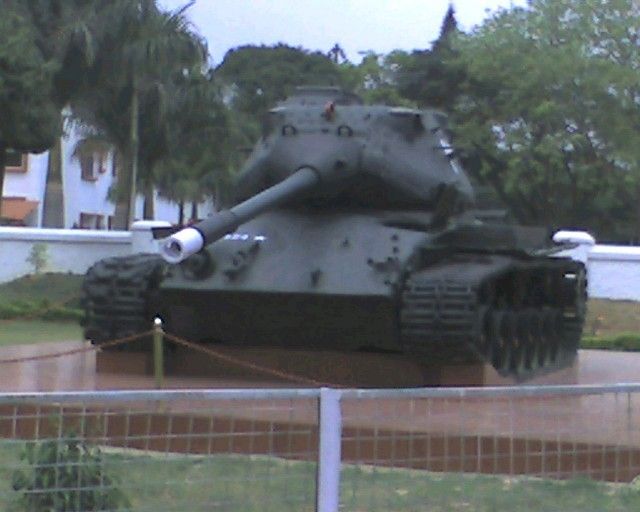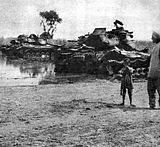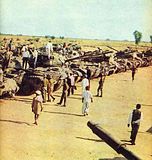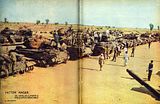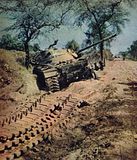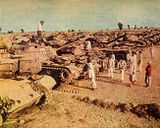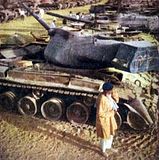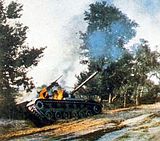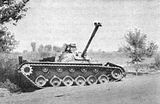1965 Indo-Pak War: News & Discussion
Re: 1965 war India- Pakistan: 50 years anniversary
I think it is Capt Amarinder Singh who came up with this first.
Re: 1965 war India- Pakistan: 50 years anniversary
Oh this Jagan fellow is everywhere, last night I was half drowsy reading and suddenly I perked up as Raghu Karnad thanked this Jagan fellow and " the repository at Bharat-Rakshak" too in his latest book.
http://www.amazon.com/Farthest-Field-In ... 0393248097
 No icon for hand clapping.
No icon for hand clapping.
The historian " Mandeep Singh Bajwa" from Chandigarh is also thanked in the book.
http://www.amazon.com/Farthest-Field-In ... 0393248097
The historian " Mandeep Singh Bajwa" from Chandigarh is also thanked in the book.
Re: 1965 war India- Pakistan: 50 years anniversary
I'd be careful with Raghu Karnad.
Re: 1965 war India- Pakistan: 50 years anniversary
Nit, Here is M.S. Gill's article in Indian Army History Thread....
http://forums.bharat-rakshak.com/viewto ... 0#p1875744
My key point if you read my post is that Lt Gen. Harbaksh Singh stood and fought and its not about Gen. JN Chaudhri.
thanks, ramana
http://forums.bharat-rakshak.com/viewto ... 0#p1875744
My key point if you read my post is that Lt Gen. Harbaksh Singh stood and fought and its not about Gen. JN Chaudhri.
thanks, ramana
-
member_29190
- BRFite
- Posts: 103
- Joined: 11 Aug 2016 06:14
Re: 1965 war India- Pakistan: 50 years anniversary
Ramana,ramana wrote:Nit, Here is M.S. Gill's article in Indian Army History Thread....
http://forums.bharat-rakshak.com/viewto ... 0#p1875744
My key point if you read my post is that Lt Gen. Harbaksh Singh stood and fought and its not about Gen. JN Chaudhri.
thanks, ramana
Not denying that Lt. Gen Harbaksh Singh fought, my post was around the story of order to withdrawal. From the two links above it could be a myth as well.
Not a millitary expert, but the trap in Asal Uttar could not have laid if we were not logistically ready. IA had plans ready for action across IB by April- May itself. They must have considered about Pakistan's 1 Armour. If the first offensive was in Jammu, it would have been fairly certain that the second one by Pak 1st Armour was going to in Punjab. There is no other worthwhile stragetic targets.
The only question was, where in Punjab. There could have some tense moments for Gen Chaudri, but I would say IA was prepared for Pak offensive across Punjab.
Last edited by member_29190 on 23 Sep 2015 22:49, edited 1 time in total.
-
member_29190
- BRFite
- Posts: 103
- Joined: 11 Aug 2016 06:14
Re: 1965 war India- Pakistan: 50 years anniversary
There was an attempt on Haji Pir in 1971, but it failed.Paul wrote:Gen Harbaksh Singh is the most underrated General of independent India, unlike Maneckshaw who appears to more of a highly efficient manager, Harbaksh Singh would definitely have been more active on the western frontin 1971. There would definitely have been stronger action by India in Zafarwal,highly competent division commanders like Zoru Bakshi were waiting in reserve on this front near Zafarwal and hardly saw action in 1971. It should be recalled that Zoru played a key role in Haji Pir capture in 65.
Results on the westrn front would have been much different with Gen Harbaksh Singh at the helm
-
member_23370
- BRFite
- Posts: 1103
- Joined: 11 Aug 2016 06:14
Re: 1965 war India- Pakistan: 50 years anniversary
In today's scenario with Brahmos- Blk III with IA , how easy or difficult is it to take Haji pir?
-
member_29190
- BRFite
- Posts: 103
- Joined: 11 Aug 2016 06:14
Re: 1965 war India- Pakistan: 50 years anniversary
A brillant video on Asal Uttar
https://www.youtube.com/watch?v=e32IFuu7pEA
As I said in my earlier post, we were ready.
https://www.youtube.com/watch?v=e32IFuu7pEA
As I said in my earlier post, we were ready.
Re: 1965 war India- Pakistan: 50 years anniversary
till around 1990s any offense into India or into Bakistan by India can only follow the five rivers up or down and trying to cross them at various points and then again going up and down. Now with UAVs, better bridge layers and better amphibious vehicles The point could be anywhere.by Nit
The only question was, where in Punjab. There could have some tense moments for Gen Chaudri, but I would say IA was prepared for Pak offensive across Punjab.
Also! The southern (as well as northern till about Gurdaspur) Amritsar District has hundreds of Historical Gurdwaras where Sikhs fought mughals. I think that this played into Gen. Harbaksh Singh's mind. For example famous villages like Sursingh, Valtoha, Jhabal, TarnTarn, Patti are all in Southern Amritsar District where Asal Uttar war was fought.
Re: 1965 war India- Pakistan: 50 years anniversary
This is not an easy watch. The wives of the martyrs of 1965 speak of their brave husbands. I salute these ladies and their families for their courage, grit and love of the country.
https://www.youtube.com/watch?v=UXe4hUHFc_o
https://www.youtube.com/watch?v=UXe4hUHFc_o
Re: 1965 war India- Pakistan: 50 years anniversary
Doubtful. Per the Official History (available in BR), Shastri wanted to continue the war but it was Gen Chaudhury who told him that the army could not sustain fighting much longer.manjgu wrote:Gen Kalkat in a news programme said that IA was prevented by political leadership to go into Lahore and cut up Pakistan. the political leadership of the day did not know how to handle a divided pakistan... the political leadership did not want to deliver a death blow to concept of pakistan.
Re: 1965 war India- Pakistan: 50 years anniversary
Well, we DID NOT know that Pakistan Army had two armored divisions to begin with! And we had no clue about the location of PA 1st Armored Division. We advanced on the same axis (albeit in east-west direction) on which PA was going to launch its assault on India.nit wrote:<SNIP> Not a millitary expert, but the trap in Asal Uttar could not have laid if we were not logistically ready. IA had plans ready for action across IB by April- May itself. They must have considered about Pakistan's 1 Armour. If the first offensive was in Jammu, it would have been fairly certain that the second one by Pak 1st Armour was going to in Punjab. There is no other worthwhile strategic targets.<SNIP>
-
member_29190
- BRFite
- Posts: 103
- Joined: 11 Aug 2016 06:14
Re: 1965 war India- Pakistan: 50 years anniversary
Personally I am yet to get convinced about the short of ammo story being the reason we did not continue the fight.vonkabra wrote:Doubtful. Per the Official History (available in BR), Shastri wanted to continue the war but it was Gen Chaudhury who told him that the army could not sustain fighting much longer.manjgu wrote:Gen Kalkat in a news programme said that IA was prevented by political leadership to go into Lahore and cut up Pakistan. the political leadership of the day did not know how to handle a divided pakistan... the political leadership did not want to deliver a death blow to concept of pakistan.
The first law of war: logistics. Gen Chaudhary ordered offensive plans by April. It is impossible to believe that the logistics were thought through. I dont believe he would had an impression that a US trained & equipped Pak army would just let us conquer their country in couple of weeks! Ammo is not willy nilly given out to units.
Add to this there were lots of battalions in defence in the Jammu region, post Op GrandSlam. They obviously would not be sitting with empty rifles.
My view, we were in a war which we didn't want. So there was no stragetic plans. Capturing Pak major cities would prove Pakistani propaganda that India does not want Pak to survice etc etc. Millitarily Pak artillery was superior, IA did not have proper co-ordination with IAF. The only thing IA would have got is casualities in going for Lahore, which most probably would have to be given back or face an Pak insurgency.
The ammo story is a nice little "blame it on Gen Chaudhry" to rescue the political class and babus.
Last edited by member_29190 on 24 Sep 2015 14:38, edited 1 time in total.
-
member_29190
- BRFite
- Posts: 103
- Joined: 11 Aug 2016 06:14
Re: 1965 war India- Pakistan: 50 years anniversary
Lt Gen Harwant Singh say we did know about the second divisionrohitvats wrote:Well, we DID NOT know that Pakistan Army had two armored divisions to begin with! And we had no clue about the location of PA 1st Armored Division. We advanced on the same axis (albeit in east-west direction) on which PA was going to launch its assault on India.nit wrote:<SNIP> Not a millitary expert, but the trap in Asal Uttar could not have laid if we were not logistically ready. IA had plans ready for action across IB by April- May itself. They must have considered about Pakistan's 1 Armour. If the first offensive was in Jammu, it would have been fairly certain that the second one by Pak 1st Armour was going to in Punjab. There is no other worthwhile strategic targets.<SNIP>
http://www.indiandefencereview.com/1965 ... iver-beas/
However, Malhotra does not elaborate as to how a maharaja ( then a captain and ADC to Harbaksh ) came in between the army chief and his army commander concerning an order of far reaching consequences at a critical stage of the battle. He also does not seem to know that, the existence of second armoured division with Pakistan was known to army HQ well before the war.
-
Akshay Kapoor
- Forum Moderator
- Posts: 1643
- Joined: 03 May 2011 11:15
Re: 1965 war India- Pakistan: 50 years anniversary
Sanju,
great post. What regt was your dad in ?
great post. What regt was your dad in ?
Re: 1965 war India- Pakistan: 50 years anniversary
very careful.Paul wrote:I'd be careful with Raghu Karnad.
the rotten apple doesn't fall far from the rotten tree.
Re: 1965 war India- Pakistan: 50 years anniversary
Thanks Akshay Kapoor. He was in Mahar. Originally MMG Regt, who got converted to Infantry.Akshay Kapoor wrote:Sanju,
great post. What regt was your dad in ?
Re: 1965 war India- Pakistan: 50 years anniversary
When India found a leader, but lost a statesman
Reading through the archives of The Hindu from September 23, 1965, you get a sense of the relief and euphoria of a nation, now united around a leader who braved immense criticism and led from the front in its time of crises. An excerpt reads: “Tributes to Shastri’s leadership: The Prime Minister’s announcement in Parliament today of a cease-fire in the fighting between India and Pakistan had an electrifying effect on the Members of Parliament and on the people.(…) (…) Members belonging to all political parties (…) praised the PM for the firm, determined and able manner in which he handled the worsening India-Pakistan relations, which finally erupted in an undeclared war.”
It is interesting then that narratives often understate the tragically short-lived Prime Minister Lal Bahadur Shastri’s significant contribution to the handling of the 1965 conflict. It is ironic that he’s often accused of “losing the war on the diplomatic table at Tashkent” or remembered for the intrigue surrounding his death. Apart from political appropriation, very little ink seems to have been spent on examining his diplomatic and political acumen which made India stronger domestically and helped regain its international stature post the 1965 crises.
Quiet strength
Shastri’s mandate was not an easy one. There was a fractured consensus within the Congress party around his ability to lead the nation after Pandit Jawaharlal Nehru’s demise. India was demoralised after the 1962 defeat and battling an acute food crisis. Pakistan’s adventurism in 1965, historians argue, wanted to take advantage of this alleged “weakness in leadership”.
In hindsight, Shastri’s handling of the war has many lessons for contemporary leaders. His biographer C.P. Srivastava, in “A Life of Truth in Politics”, recalls that Shastri’s slight build was often mistaken for a lack of ability, but really concealed a very sharp mind.
This plays out from the first meeting between Prime Minister Shastri and Pakistani President Ayub Khan, says former ambassador M. K. Rasgotra, who was a war book officer at that time. The former diplomat recalled a conversation between Gen. Khan and his Foreign Minister Z.A. Bhutto soon after meeting Shastri in Karachi in October 1964. Gen. Khan had reportedly remarked, “This little man. What will I speak to him?” This was “a total miscalculation as time would prove,” Mr. Rasgotra says. Shastri’s observations, however, were quite astute. He assessed Khan as practical, but described Bhutto as “someone who could throw the spanner in the works for Indo-Pak relations,” records his biographer. A prophetic observation given how 1965 played out.
Firm stand
Contrary to expectations, Shastri had responded to Pakistani provocations on the border through speeches in Parliament from the very beginning, making India’s red lines clear, says Srivastava. He was determined to convince President Khan that ‘India had no desire whatsoever to acquire even one square inch of Pakistani territory [...] [but] would never allow any interference by Pakistan in Kashmir which was an integral part of India.’
During the Rann of Kutch incident, a probing exercise by the Pakistani forces in early 1965, Shastri withstood immense pressure from the opposition to resolving the issue through an international tribunal. Having agreed to the ceasefire, his government survived a no-confidence motion to defend the decision of arbitration. Very few knew, reveals Srivastava, that Army Chief J.N. Chaudhuri and Air Chief Marshal Arjan Singh were against escalating the conflict, as the terrain was unsuitable for large-scale operations by India.
Politically, arbitration was seen as capitulation and many demanded its rollback. Shastri stood his ground, arguing India would not be a ‘irresponsible nation”, reneging on an “international commitment”, records Srivastava — a stance that would later bolster India’s position in the UNSC ceasefire dialogues.
Shastri’s ability to lead and carry the nation in the face of surprise attacks was exemplified during the failed attempt by Pakistan to stir an uprising in Kashmir in August 1965. Shastri responded with a clear policy response: India would not approach the UNSC and defend its territorial integrity; no interference from Pakistan would be tolerated; contingency plans — especially vis a vis China — would be prepared; and the nation would be kept abreast of all government decisions. He articulated this in a public address on August 13, 1965, which assured the nation that ‘force will be met with force’. There was no room for speculation.
Indian forces had to capture the Haji Pir Pass and the Kishen Ganga bulge, the two supply routes for infiltration into the valley to thwart the attacks. This operation required crossing the Cease Fire Line. In another bold first for India, the forces were assured of the firm backing of the Prime Minister and told the government would handle the consequences, records Srivastava.
The boldest decision came in September 1965, when Pakistani Patton tanks rolled into Chambh in J&K, aiming to capture Amritsar and more. When advised that to defend Kashmir, a diversionary attack in West Pakistan was needed to push enemy forces on the defensive, Shastri’s iron will came into play.
Srivastava, then joint secretary to the Prime Minister, recalls Shastri pacing up and down in his office on September 1, 1965. He says “All I heard him say was:ab toh kuch karna hi hoga (now something has to be done)”. He then convened an emergency cabinet meet “to carry his colleagues with him in his decision” and prepare for repercussions to India’s stand. On September 3, Shastri asked the Indian forces to march to Lahore, the first time that India would take the battle to the invader’s territory.
Through all of this, Shastri had ensured India’s able representation in the UNSC and convinced the big powers of India’s response as proportionate to Pakistani aggression, was briefed constantly by military commanders, consulted the opposition, and even organised regular press briefings to inform the people and instil confidence in the leadership.
Even his much-criticised decision to “return Haji Pir pass” during the Tashkent Conference, it is argued, was not done under pressure. His biography reveals that Shastri knew international opinion would shift if India refused, as it was a pre-requisite to the UNSC ceasefire resolution.
He was also aware that giving up Haji Pir would invite scathing accusations of betrayal domestically. Before Tashkent, records Srivastava, the military chiefs had told Shastri that while they would not want to vacate, “it could not come at the cost of peace in the subcontinent”. Perhaps Prime Minister Shastri became the fall guy to circumstance.
1965 clearly has lessons for conduct of government and diplomacy for the present day establishment. We both found a leader and lost a statesman, perhaps a little too soon.
(Shruti Pandalai is a former journalist and research scholar with the Institute for Defence Studies and Analyses, New Delhi.)
Re: 1965 war India- Pakistan: 50 years anniversary
Tomorrow is the last date, Indian Army exhibition at India Gate
https://www.facebook.com/media/set/?set ... 500&type=3
https://www.facebook.com/media/set/?set ... 500&type=3
Re: 1965 war India- Pakistan: 50 years anniversary
Good article - don't know if it was posted here - will just post the arrogant mofo way in which the Chinese speak when the feel they are strong. Must not forget this as we get stronger
http://www.thehindu.com/opinion/op-ed/1 ... 608385.ece
http://www.thehindu.com/opinion/op-ed/1 ... 608385.ece
The Chinese were only too happy to come to Pakistan’s rescue if one looks at the details that emerge from the records of Gauhar as also from the war diaries of the then Indian Defence Minister Y.B. Chavan (1965 War: The Inside Story, by R.D. Pradhan). They outline that Chinese Foreign Minister, Marshal Chen Yi, had already met with Foreign Minister Zulfikar Ali Bhutto in Karachi on September 4, 1965 and assured Pakistan support against “India’s armed provocation in Kashmir”. China followed this up with a statement on September 7 which said, “The Indian government probably believes that since it has the backing of the U.S. imperialists and modern revisionists, it can bully its neighbours, defy public opinion and do whatever it likes,” records Gauhar.
According to Chavan’s war diaries, China had previously, on August 27, accused the Indian Army of committing acts of aggression on the border of Sikkim and Tibet in July and August, accusations that were rejected by India.
By September 8, it renewed these accusations claiming, “India must bear responsibility of all consequences arriving therefrom,” which India again rejected and called for a neutral and independent observer to visit the China border and look at these complaints.
On September 17, notes Chavan, the Chinese again upped the ante, dismissing India’s offer as “pretentious” and sending a fresh note accusing India of “maintaining 56 military installations on the Tibetan side of the Sikkim-Tibet border and demanding their dismantling within two days or face grave consequences.”
Re: 1965 war India- Pakistan: 50 years anniversary
IDSA:AIPOWER IN 1965 INDO-PAK WAR
The United States (US) Secretary of Defence, Robert McNamara,
had told Y.B. Chavan, India’s new Defence Minister, on a visit to the US
in search of military equipment:
Mr. Minister, your air force is like a museum. I wonder whether
you are aware of the variety of aircraft in your air force. You are still
operating with Hunters, Spitfires, Vampires, Liberators, Harvards—
exotic names of World War II vintage. All these aircraft are only
worthy of finding a place in the museum. 3
I recall...a meeting between Prime Minister Shastri and
President Ayub during the Commonwealth Conference session...
Ayub said somewhat patronisingly, ‘You know, your chaps tried
to commit aggression on our territory, our chaps gave them a few
knocks and they began to flee.’ Then Shastriji said ‘Mr President,
you are a General. I have no military knowledge or experience. But
do you think if I had to attack Pakistan, I would choose a terrain
where we have no logistic support and you have all the advantages?
Do you think I would make such a mistake or any of my Generals
would allow me to make that mistake?’ And one could see from the
face of President Ayub that this thought startled him...I could see
him visibly pause and not pursue the point any further (author’s
emphasis). 8
Re: 1965 war India- Pakistan: 50 years anniversary
From the same article:
Joint Planning
This was conspicuous by its absence throughout. In his autobiography,
Air Chief Marshal (ACM) P.C. Lal, who was then Vice Chief, blames
General J.N. Chaudhuri for this lapse. Although Chavan held morning
meetings daily with the three Chiefs, and Defence Secretary and other
important officials, and the COAS often attended the ECC meetings, he
seldom took along the Naval Chief or the Air Chief. The COAS also was
a rank higher than the Air Chief. It is obvious that the plans for the attack
in Punjab were not shared with the Air Chief. It is also quite possible that
PM and the Defence Minister did not want these plans to be shared at a
level lower than that of the Chiefs of the Army and the Air Force. Even
though during the 22 day-long conflict the Chiefs were regularly meeting
each other, and also the Defence Minister and the Defence Secretary, who
in turn was briefing the Prime Minister every evening, and yet there was
little prior consultation or planning.
Re: 1965 war India- Pakistan: 50 years anniversary
What alarm signals I any were raised after the Sino-Pak agreement in March 1963? This was a full two years before the Sept 1965 war.
Nehruji was still alive for one more year.
Nehruji was still alive for one more year.
Re: 1965 war India- Pakistan: 50 years anniversary
The 1963 Sino-Pak border resolution document is an interesting piece which should've told India which way the wind is blowing. Apart from Shaksgam Valley, the document accepts Chinese claim on Aksai Chin and as per it, the northern limit of Pakistan and Chinese boundary in Aksai Chin is Karakorum pass.ramana wrote:What alarm signals I any were raised after the Sino-Pak agreement in March 1963? This was a full two years before the Sept 1965 war.
Nehruji was still alive for one more year.
Re: 1965 war India- Pakistan: 50 years anniversary
I think India knew fully well which way the wind was blowing - judging from multiple references. First, every serious commentary on the 1965 war points out that India was in a phase of massive military expansion in 1965 with some units having been newly raised with no combat experience. Secondly the China threat was always known - leaving a large percentage of India forces tied up at the China border even in 1965.rohitvats wrote:The 1963 Sino-Pak border resolution document is an interesting piece which should've told India which way the wind is blowing. Apart from Shaksgam Valley, the document accepts Chinese claim on Aksai Chin and as per it, the northern limit of Pakistan and Chinese boundary in Aksai Chin is Karakorum pass.ramana wrote:What alarm signals I any were raised after the Sino-Pak agreement in March 1963? This was a full two years before the Sept 1965 war.
Nehruji was still alive for one more year.
A third data point is that the Paki knew that the Indian armed forces were in expansion mode and that is why Ayub thought that 1965 would be the last chance to grab Kashmir.
Re: 1965 war India- Pakistan: 50 years anniversary
https://www.youtube.com/watch?v=4EEMqpHslVQ
Video on 1965 war by ADGPI: Indo Pak 1965 War, a Blaze of Glory
Video on 1965 war by ADGPI: Indo Pak 1965 War, a Blaze of Glory
-
member_29190
- BRFite
- Posts: 103
- Joined: 11 Aug 2016 06:14
Re: 1965 war India- Pakistan: 50 years anniversary
And before things went nuclear. Chinese tested in 64. Pak must have assumed 3-4 years before india went nuclear.shiv wrote: A third data point is that the Paki knew that the Indian armed forces were in expansion mode and that is why Ayub thought that 1965 would be the last chance to grab Kashmir.
I always wondered if there was any chinese nuke threat angle to the ceasefire.
Re: 1965 war India- Pakistan: 50 years anniversary
johneeG wrote:SSridhar saar,
Link1965 decided fate of the subcontinent
ShareComment
Text size: A A A
Last updated on: September 06, 2005 17:48 IST
Though the 1965 Indo-Pak war was only a medium-scale, limited war that lasted less than three weeks, it resulted in the Tashkent Agreement that brought about exchange of territories occupied by both sides.
It is largely seen as a stalemate in Pakistan and the rest of the world, but the 1965 war generated very significant consequences that decided the fate of the Indian subcontinent.
The Pakistani leadership carefully planned the war. It was meant to lead to a massive uprising in Kashmir engineered by sending in Pakistani infiltrators. Further, by clandestinely raising a second armoured division of relatively sophisticated Patton tanks, Pakistan aimed at a breakthrough in Punjab against the weak and obsolete Indian armour and wanted to cut off Jammu and Kashmir from India.
Field Marshal Ayub Khan also was planning to demonstrate -- in the wake of the Indian Army's debacle at Sela-Bomdila in Arunachal Pradesh in November 1962 -- that one Pakistani was equal to 10 Indians in terms of military prowess.
His conviction was that the Hindu, when struck a timely and decisive blow, would not be able to stand up. His confidant Altaf Gauhar has recorded this in Ayub Khan's biography.
Pakistan had China's support. When Islamabad appealed for support, Beijing did try to apply pressure on New Delhi by delivering a not very credible ultimatum to India.
The Americans were well informed about the possibility of Pakistani infiltration into Kashmir and the subsequent offensive months in advance, as has been recorded by the then Central Investigative Agency operative in India, Duane Claridge, in his book A Man for All Seasons.
The American military and political establishment had concluded that in case of a war, Pakistan would win.
The Pentagon and Harvard University played a war game at the Institute of Defence Analysis, Washington, DC, in March 1965. The war game and its results were available in a book, Crisis Game by Sidney Giffin, by the spring of 1965.
The total failure of the Kashmir uprising, the complete destruction of the Pakistani Patton Armoured division at Khem Karan in Punjab and the Pakistan Army running out of ammunition and being saved from total humiliation through the UN ceasefire constitute a turning point in the history of India-Pakistan relations.
Having engineered the war and seen it result in a disaster, Zulfikar Ali Bhutto turned against his benefactor Ayub Khan and blamed him for the Tashkent Agreement. His propaganda was that Ayub Khan threw away a military victory.
The Pakistani people were not informed about the failure of Operation Gibraltar, the attempted infiltration into Kashmir and thereafter of Operation Grand Slam, the attack on Jammu. The Indian counterattack in the Lahore sector was depicted as Indian aggression. The decimation of the Pakistani armoured division by a poorly armed Indian armoured brigade through superior tactics at Khem Karan was also not told to the Pakistani people.
But all these attempts at obfuscation did not deceive a leader like Sheikh Mujibur Rahman, considered the father of Bangladesh. When the question was raised about the security of what was then East Pakistan vis-à-vis India in case of another war, Bhutto, as foreign minister, implied in his answer that Pakistan depended on Beijing to ensure the security of that part of its territory.
That led Rahman to ask for greater autonomy from Islamabad and to formulate his six points which became the basis for the subsequent secession of Bangladesh from Pakistan.
The 1965 war also led to an embargo of US arms supplies to Pakistan. Islamabad's use of American arms against India was against the assurances given by President Dwight Eisenhower to Jawaharlal Nehru that in case Pakistan used US-supplied arms against India, necessary corrective action would follow.
Though the US bureaucracy and the Pentagon were prepared to look the other way if Pakistan had won the war, they found it difficult to overlook the miserable performance of Pakistani armour at Khem Karan. Pakistan therefore turned to China and France for re-equipment of its forces. After 1965, China became the foremost supplier of arms to Pakistan.
From Bhutto's death cell testimony, it also becomes clear that Pakistan initiated its discussions with China on acquiring nuclear weapon technology around 1965. Bhutto talked of completing his 11-year-long negotiations successfully in 1976. It would not be incorrect to say that the Chinese-Pakistani strategy of containing India began in the aftermath of 1965 war.
Pakistan drew correct lessons from the failure of Operation Gibraltar when the Kashmiris did not rise against India in consequence to large-scale infiltration of Pakistani commandos into the Kashmir valley. They bided their time and in the late 1980s trained disaffected Kashmiris, who crossed over into Pakistan Occupied Kashmir, in arms and infiltrated them back.
That this strategy too did not wholly succeed is a different story but it did begin the prolonged proxy war against India in Kashmir.
Pakistan also discovered it was not difficult to run rings around the conditions of American arms supplies and hide things from US inspection teams. They were able to covertly raise a second armoured division in 1965. Unfortunately for them it did not give them the victory in Punjab they expected. The second armoured division met its defeat at Khem Karan.
Pakistan used this experience of getting around US procedures in the 1980s to divert American arms -- meant for Afghans fighting Soviet forces -- to arm the various jihadi militias and to install the Taliban regime in Kabul.
On the Indian side too, the 1965 war led to significant results. The Indian Army failed to assess intelligence effectively in respect of construction of aqueducts under the Ichogil canal (that runs from India to Lahore) and on Pakistan covertly raising a second armoured division. Thus, the external and internal intelligence collection and reporting were bifurcated. A dedicated external intelligence agency the Research and Analysis Wing -- was created.
An ill-advised reorganisation proposal in respect of Indian armour increasing light armour and reducing medium armour - strongly espoused by General Joyanto Nath Chaudhuri before the war, was given up. The Indo-Soviet arms supply relationship got reinforced and the Soviet Union became the sole supplier of arms for India.
Though it is not much written about, India intensified its support to Sheikh Mujibur Rahman and his Awami League in their demands for greater economy from Islamabad.
The 1965 war demonstrated that the 1962 debacle was not a reflection on the Indian Army but was the result of inadequacies in a few top inexperienced generals. It also proved that Indian unity was solid while Pakistan was vulnerable to divisive forces. It brought out that American short-term Cold War calculations overrode Washington's commitment to democracy.
It also highlighted that the US establishment had very wrong assessments about the Indian leadership, the Indian Army and India's ability to survive as a Union and grow into a major power.
The legendary K Subrahmanyam is the doyen of India's strategic thinkers.
K Subrahmanyam
The author of this article is K Subrahmanyam who is highly respected and is the father of the present Foreign Secretary of India.
----
I don't see any ups and downs in Amirkhan-Pakistan relationship. Pakistan depends on Amirkhan and therefore has to toe its line. Pakistan doesn't have the luxury to defy Amrikhan on any issue. It suits Amirkhan to project the image of a rogue Pakistan just as it suits Pakistan to project the image of a rogue ISI just as it suits ISI to project the image of a rogue Taliban.
b) I think chacha's anti-americanism was a hog-wash and should not be taken too seriously. Chacha was an anglophile. Even if we take his anti-americanism seriously, that stance was totally changed after 1962.
Re: 1965 war India- Pakistan: 50 years anniversary
The actual book is "A Spy For All Seasons : My Life In The CIA". The other book erroneously referred is a play by Robert Bolton.The Americans were well informed about the possibility of Pakistani infiltration into Kashmir and the subsequent offensive months in advance, as has been recorded by the then Central Investigative Agency operative in India, Duane Claridge, in his book A Man for All Seasons.
Re: 1965 war India- Pakistan: 50 years anniversary
I flew every day of the war

With a passion for fighter planes since growing up as a boy in the North West Frontier Province in pre-Partition India, Wing Commander Jagdish Chandra Sabrehwal flew nearly all the fighter aircraft in the Indian Air Force till he retired.
I have flown almost all fighters in the IAF till the time I served. I have also flown helicopters and small aircraft like the Dornier. My favourite is the Hunter that I flew in the 1965 War.
I have flown the Mystere, Gnat, Sukhoi, Hunter, Spitfire, Howard, Vampire, Dornier and Mi-4 helicopter.
-
Virender
- BRFite -Trainee
- Posts: 29
- Joined: 04 Dec 2008 08:29
- Location: Cold, narrow but not so dark place
Re: 1965 war India- Pakistan: 50 years anniversary
Just a question.....What happened to the captured Pattons which were in working order?Did we induct them or sold to some third country?
Re: 1965 war India- Pakistan: 50 years anniversary
Was this posted?
http://bharatkarnad.com/page/2/
http://bharatkarnad.com/page/2/
Distinctive attributes of the 1965 War
Posted on August 28, 2015 by Bharat Karnad
Beyond the plans and the preparations, Wars by their very nature are hit and miss affairs. The hits are mainly attributable to acts of incomparable bravery, of determined and resolute action by a few to turn events around. These are the singular events which when aggregated over time and over the expanse of the battlefield constitute victory; their absence, defeat.
With the GOI, for the first time, celebrating the 1965 India-Pakistan conflict — albeit its “Golden Jubilee” — in a big way, it is time to tot up the distinctive attributes, persons and events that stand out from a medley of incidents and extraordinarily brave individuals, whose reputation is burnished, many of whom won no recognition at the time or since.
In bullet points:
1) the two formations that the rival armies considered elite, their spearheads — the very best, curiously, the 1st Armoured Divisions of both the armies flopped! The Indian 1st Armrd Div deployed in the Sialkot sector went up against the Pak 6th Armrd Div — a unit without history and cobbled together literally on the run! The Indian Div was virtually decimated at Phillorah and Chawinda. Its Pak counterpart featuring the most modern tank then in existence — the M48 Patton, didn’t fare much better. Tasked ambitiously not just to lead the charge on Amritsar, but cross the Beas River, take Jallandhar on the way to making a run to Delhi. Really! It, however, faltered at the very first step in the Khemkaran area, held off for the crucial first 3-4 days of the war by only four antiquated Sherman tanks of the Deccan Horse led by the indomitable Colonel Fahad Bhatti, who won no recognition, other than a measly VSM. As Colonel AR Khan then a junior officer with the 4 Grenadiers in that action recalls, Bhatti had no godfathers, no recommenders. But he was a karm yogi. The other tank unit that was supposed to assist Bhatti — the 2nd Independent Armoured Brigade was described by Khan as neither independent, nor armoured, nor even a brigade (which description is along the lines of that of the Grand Trunk Express — not grand, trunk, or express). Bhatti afforded the rest of the units of the 4th Mountain Division under Maj Gen Gurbaksh Singh time to firm up, eventuating in the justly famous battle of Assal Uttar that broke the back of the Pak advance and its armoured strength in the Khemkaran area. The Patton was brought down mostly by the light field gun — the 105mm recoilless outfitting a unit that just prior to Sept ’65 was honing its skills in mountain fighting. That the small force of Deccan Horse stopped the Pak 1st Armrd Div in its tracks was fortuitous, because there was nothing behind it. It highlights the inglorious fact of frontline units just melting away — units, which as Col Khan said, shall remain unnamed!
This episode suggests that the fame and reputation of fighting units matter very little in hostile engagements. It is the grit and the stomach for a fight that matters more.
2) Assal Uttar was won also because the Pattons couldn’t move rapidly through the slush and the mud created by the deliberate breaching of the Roha Nala, and were often stuck — sitting ducks, their tracks running in place, and picked off by Indian gunners at will. (This tactic of flooding the battlefield, was used by the Iranian forces but ended up bogging down both Iranian and Iraqi tanks in the Susangerd sector in 1981 in the largest tank battle of that war, when the west bank of the Karun River was breached).
3) Talking of grit — no finer illustration of it than the 3 Jat of the 15th Infantry Division under the luckless Maj Gen Niranjan Prasad (who had previously made a hash of things in the 1962 War leading the 4th Division, and somehow survived that fiasco without being cashiered). Led by the iron-willed Lt Col Desmond Hayde, the 3 Jat crossed the Ichhigoil Canal and took Dograi and secured a lodgement in Batapore on the outskirts of Lahore not once (the first time on Sept 6) but twice — the second time on Sept 21 after the Pakistanis had strengthened that position with tanks and artillery. The 3 Jat were asked to withdraw the first time around owing to relentless aerial attacks by Pak F-86 Sabres, which is when the Pakistanis came back. Even so Hayde’s unit succeeded again.
I remember two things about this set of actions: in 1982 the then retired Brigadier Hayde — a Britisher who “stayed on” (in a letter to me, memorably described his son “as first generation Indian” and who, like his MVC-decorated father, joined the latter’s paltan and went on also to command it) wondered why there was no countervailing response and protection offered by the IAF over Dograi. The absence of Indian counter-air was something the Western Army commander during this war, the redoubtable Lt Gen Harbhaksh Singh too was livid about (when I met him in his Vasant Vihar home in the early Nineties). He hinted at dark happenings in Delhi, besides of course, cursing Niranjan Prasad in the most violently abusive language!
The explanation for the absent IAF, per my lights, and which I have dilated on elsewhere in my writings, is political. The unexpected breakthrough over a supposedly Pak-fortified Lahore front, confronted PM Lal Bahadur Shastri with a politically pregant option of allowing Harbhaksh, who immensely desired it, to take Lahore. I suspect though that Shastri and his advisers must have considered the ramifications of such capture, and thought better than to green signal such a move. I have speculated that this was because at that time Lahore was the socio-cultural centre of gravity of Pakistan. Had it been captured, rather than merely being invested — capturing that city would have required 4-5 Divisions — could have led to the unraveling of Pakistan, with what consequences for the subcontinent can only be imagined. This thesis of mine is also borne out by the express instructions from MOD to the Navy under Soman to keep out of any action, not even to react to the provocation of the Pakistani naval shelling of Dwarka.
3) And, of course, we are absolutely hideous at winning the peace, after finishing the hard work of winning wars. Indira Gandhi did not impose a victor’s peace that international laws of war permitted India after its resounding victory in 1971 — when the minimum that could have been insisted upon was the formalisation of the ceasefire line — LOC — in Jammu and Kashmir as the international border, and thereby settling that dispute for once and for all. Instead she succumbed to Bhutto’s oily theatrics and his pleadings asking for time to garner support for this with his people, when the correct stance would have been to tell the slippery Zulfikar Ali B that how he managed to get support from his people was his problem, and that he’d have to sign an ag to make LOC international border if he wanted the return of the 93,000 Pak POWs. Then again, there was precedent. Six years earlier, Shastri at Taskent, likewise, accepted a grovelling Ayub’s plea to let him return with some respect, whence the Haji Pir salient captured by 1 Para was restored to Pakistan.
It points to the lack of any real understanding of anything remotely military by the political class, leave alone appreciation of, and sensitivity to, strategic geography. That is to say our political leaders have always lacked, and still do, what Halford Mackinder called “the map reading habit of mind” and the country has paid a heavy price, and continues to do so.
Re: 1965 war India- Pakistan: 50 years anniversary
being the first combat operations for IAF, what were the typical formations flown on attack missions?
Two, four planes etc.?
And strike planes accompanied by higher altitude CAP?
Two, four planes etc.?
And strike planes accompanied by higher altitude CAP?
Re: 1965 war India- Pakistan: 50 years anniversary
The Vampire strikes initially had no CAP and were in packages of 4.
BTW - are there any really good photos of Centurion tanks during the war ?
BTW - are there any really good photos of Centurion tanks during the war ?
Re: 1965 war India- Pakistan: 50 years anniversary
Air Marshal Denzil Keelor reminisces. very lucid. Very succinct. A valuable 7 minute history chronicle and a must watch
https://www.youtube.com/watch?v=fbCZQ79eoDQ
https://www.youtube.com/watch?v=fbCZQ79eoDQ
Re: 1965 war India- Pakistan: 50 years anniversary
Here's one of a Centurion entering Phillora: https://twitter.com/SpokespersonMoD/sta ... 1631841284
